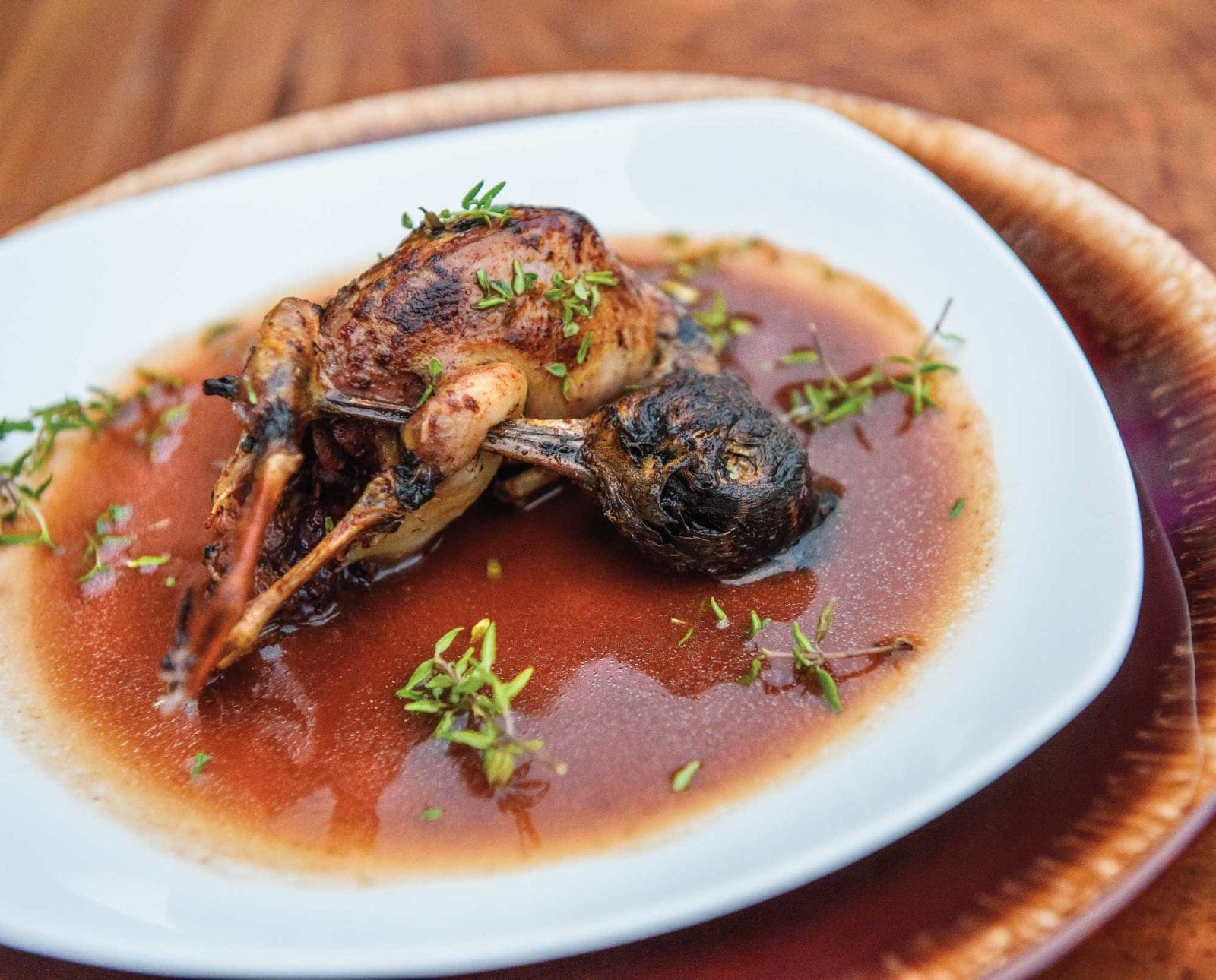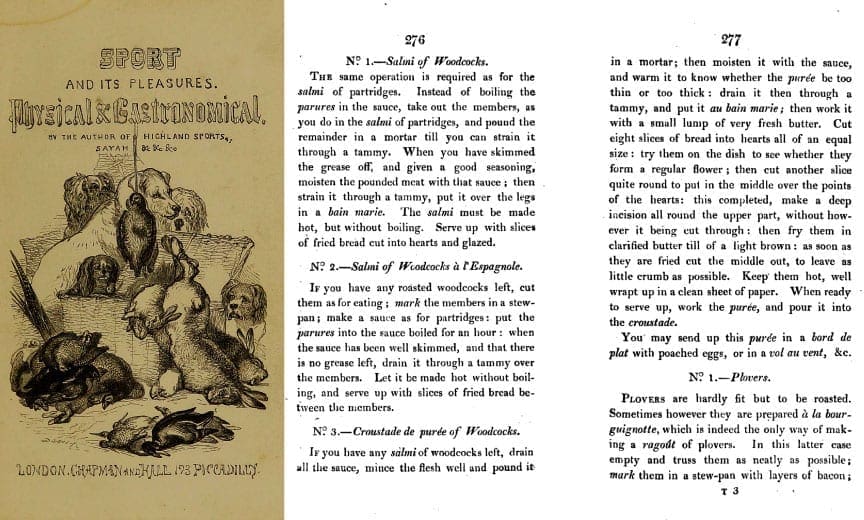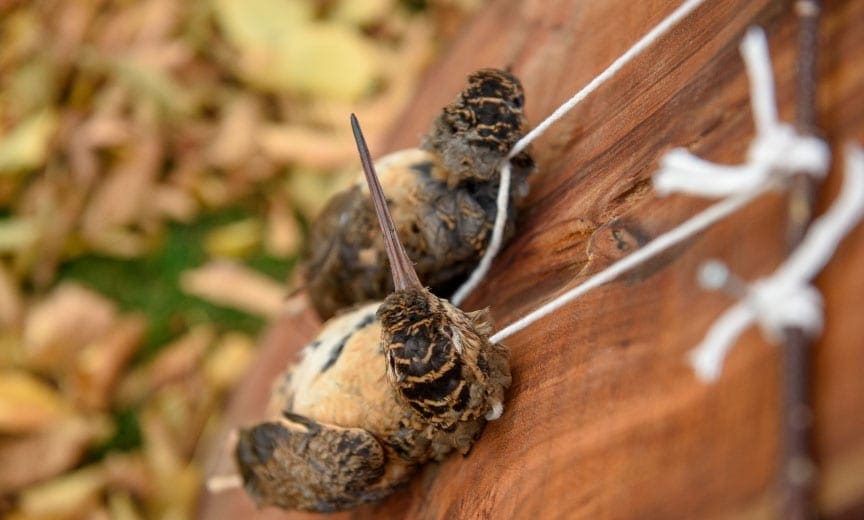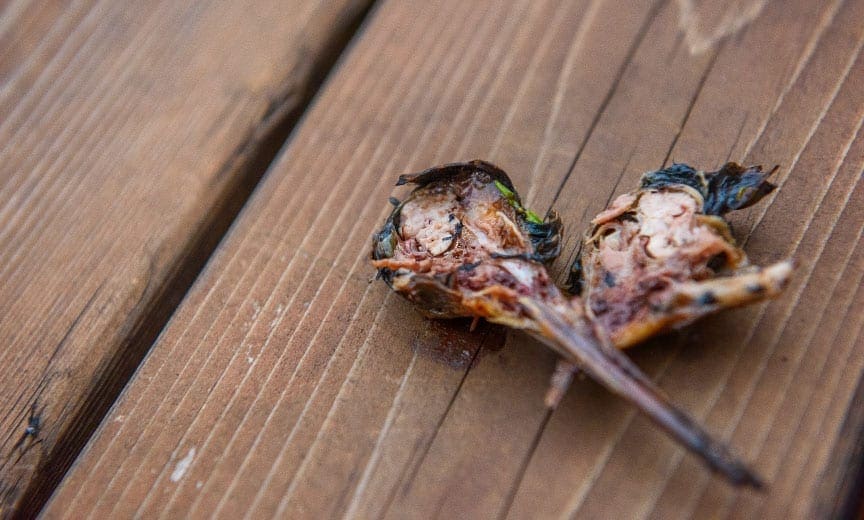Home » Small Game Cooking » Aging Woodcock for Cooking – Process and History
Aging Woodcock for Cooking – Process and History

Raised a Minnesota farm-girl in a sporting family, Krissie Mason…
What we learn from hanging and roasting these curious morsels of antiquity
Many wild game oddities have passed from sportsmen friends to my kitchen. Sometimes, in what seems like a scene from a Breaking Bad clandestine mule drop, I make a final right-hand turn and text my dealer upon arrival, “Here.” He emerges from the building and heads to the rear of vehicle, dropping the tailgate and pulling any number of hastily double-zip-locked bags from cover: antelope heart, bear ham, muskox loin, whole raccoon, elk tongue, and one time five hairy whitetail testes.
Today’s drop yielded a pair of fresh, fully feathered American woodcock from northern Minnesota. As such, they presented a perfect opportunity to venture into the historical culinary practice of hanging birds to ripen, head and entrails intact, before a simple roasting. Having never prepared upland birds in this traditional manner, I had questions. How does one properly ripen a gamebird? For how long? What temperature? How does one know when it is ripe? And where do you hang them in a modern world, sans a dank medieval castle, thatched Merrie Olde English cob hunting lodge, or ancient barn of wattle and daub?
Historical context
Part journalist, part hobby-historian, and intensely curious, I began a full-day deep dive into historical documents trying to trace the principle to its source, and its custom to its origin. I found an old English, pre-7th Century reference to “wudecocc,” and then a high correlation on hanging and preparing “wodcoke” or “wuducot” from hand-scribed works dating to the 14th, 15th, and 16th Centuries of England and France. The term itself is Anglo-Saxon in origin and referred to a naïve bird, or a bird easily caught.

Why the concentration in England and France? The birds were an abundant food source, since the British Islas served as safe harbor for the migratory patterns of Eurasian woodcock, as flocks traversed the skies of Russia and Scandinavia, and across the North Sea, landing on the coasts of Yorkshire and Lincolnshire, and then on to Brittany, France.
Here are just a few of the many culinary titles found with references to preparing woodcock. (All suggested curlews, godwits, and snipe could likewise be prepared).
- France, circa 1380, Le Viandier de Taillevent
- England, circa 1430, Two Fifteenth-Century Cookery Books
- England, circa 1430, Liber Cure Cocorum
- England, circa 1460, Wagstaff Miscellany
- England, circa 1468, A Noble Boke off Cookry
- England, circa 1508, The Boke off Keruynge
- England, circa 1591, A Book of Cookrye
- England, circa 1596, The Good Housewife’s Jewell
- France, circa 1604, Ouverture de Cuisine
- England, circa 1609, Delights for Ladies
One book of particular note covers a period from the reign of King Edward III, circa 1312, all the way through King William and Queen Mary, circa 1694. It’s called Ancient Cookery and was published as an accompaniment to Ordinances and Regulations for the Government of the Royal Household, also known as the Privy Purse. The manuscript details the day-to-day governing of the royal household. It notes how the royal person was attended upon when in full court, at public festivals, and assemblies—also how royal affairs should be conducted upon journeys, hunts, and “progresses” in the country. The entries convey an idea of the manner of living at the different periods to which they relate, and of the expenses incurred to support the sovereigns and their families. Additionally, it describes the manner and types of dishes served at royal tables—how they were composed, and how they were prepared. Many familiar recipes can be found in the ancient tome, for birds, fishes, and beasts that we still cook today. In order to follow them, you’ll just have to slog through Middle English linguistics and calligraphy for a best-guess translation.
Though not from the Middle Ages, a final cookbook of note is The French Cook, or The Art of Cookery in all its Branches, which was published in 1813 by one of the generation’s great 19th Century chefs, French-born Louis Eustache Ude (1769‒1846). As the title suggests, it is a handbook of French cuisine, widely accepted in England at the time as the standard for fine cooking.
Ude was a kitchen apprentice for King Louis XVI and Marie Antoinette prior to the French Revolution. While still a young man, he relocated to England, where he lived and worked for the rest of his life. As the chef for Louis XVI, Napoleon’s mother, the Earl of Sefton, and the Duke of York, Louis Eustache Ude certainly knew his way around a woodcock.
How to do it
All historical recipe books noted a vague 4- to 10-day ripening period, which, I imagine, was dependent on temperature and humidity. The birds were to be hung whole, fully feathered, with entrails intact. This aided tenderization and enhanced the flavor of the meat. My garage, far be it from structures of olde, hovers around 45 degrees in late fall. I figured it would work fine for hanging birds.

No mention was made in medieval texts regarding hanging by head or feet, or any particulars on a method for hanging. Lacking a pegged, hand-hewn 500-year-old timber truss, I took liberties by pounding a couple of small nails into a live-edge cherry slab often used in my kitchen as a cutting board. I stood it on end, slipped a small noose of cotton butcher’s twine loosely around the neck of each bird, looped the twine around a stick, and then fastened it to the nails on the board. Easy enough.
I checked the birds once a day, giving a light tug on the tail feathers. Nothing until day six, when the gentle pinch and pull of my thumb pad and index finger returned a few. The birds were ready to pluck and roast in the manner directed by the old books of “cookrye.”
I cracked a nice English ale and moved from the garage to the deck off my kitchen to pluck. The temperature outside was about 30 degrees. I had a female and a male bird. As I removed the feathers from the larger hen, I could see her underparts appeared to be swollen. She had taken a lot of shot and it appeared some grains may have damaged the intestines, causing bacterial spoiling. Regardless, I continued on. The male was in good shape. His plucked body showing no signs of possible spoilage.
As directed by the medieval gastronomes, head and its feathers were intact, and the entrails remained in the body. I cut the wings from both birds and brought them to the sink to rinse. Once in the confines of a warm home, it did not take long for my nose to reveal the hen was rancid. I would not be roasting it.
I trussed the remaining woodcock, with its own long beak, by gently pulling the neck and head to the side and spearing the legs with the bill. The bird becomes fragile after a six-day age.
Next, with a lighter, I singed off any body feathers that remained. Having been ripened, the plucking was easy, so I found very few. I tossed some butter in a cast iron skillet and quickly browned the bird on its back, breast, and sides. A minute or so in each position worked well. I then popped the skillet into a preheated 450-degree oven for about five minutes. I removed the bird and let it rest a few minutes while I made a quick sauce by deglazing the pan with a bit of red wine and seasoning with fresh thyme, salt, and pepper. I cut the head from the neck and sliced the head in half lengthwise with a sharp knife. I then drained and then plated the bird in the juices.
In the Middle Ages, this dish would have been eaten with the hands, tearing apart the bird and lapping the entrails from the cavity. The roasted, hazelnut-size brain, the most prized morsel of all, would have been scooped with the bird’s beak, or simply taken in the mouth by the guest of highest esteem and sucked clean.
According to Sport and Its Pleasures, Physical and Gastronomical published in 1859:
“The wood cock is the first on the list of gastronomical indulgences of the feathered tribe denominated ‘game’ not only from its aroma, but also from the succulence of its flesh, so prized by all who are judges of gastronomical excellence.
The woodcock roasted is the most distinguished dish one can offer to a person of high consideration. In fact, it is the highest mark of your respect and esteem. A gastronome venerates the precious dish to such a degree that he desires to prove his appreciation by tendering it its highest honors. Suffice it, that even its entrail is previously preserved on toast, and eaten with respect by the most enlightened amateurs.
The woodcock also may with the aid of a mortar be pounded into a delicious puree as a foundation to a dish ‘ot coutlets’” . “This puree, which if properly treated requires the highest degree of artistical talent, is without question the most delicious dish which can honor the table of a man of taste.
Men of genius in fact consider it the highest gastronomical pleasure permitted to man. And if he takes precaution to bring out the flavor by hanging and soften the aroma by some first-rate Bordeaux he may flatter himself that he has dined well.
The woodcock is The Prince of game.”

What I learned
1. Hanging tenderized and enhanced the flavor.
2. Plucking ripened birds was easy, but care must be taken not to tear paper-thin skin.
3. Severely shot-up birds don’t work.
4. Roasting head feathers at 450 degrees smell bad. Very, very, bad!
5. Woodcock brain is a rare delicacy that tastes like soft, buttery pâté. Much to my surprise, it was my favorite part of the bird.
Raised a Minnesota farm-girl in a sporting family, Krissie Mason is a writer, photographer, editor, outdoorswoman, and wild game food enthusiast. She is a regular contributor to a variety of outdoor lifestyle magazines, destination publications, and websites. In addition to other outdoor pursuits, she has recently become addicted to fly-fishing. Krissie fully supports a field-to-fork wild food-chain and enjoys expanding pantries and stretching wild fish & game palates with ambitious and delicious recipes.





Terrific article. Preparation and Cooking directions very similar but more detailed than tthose provided by the “ScottReaProject” you tube video (he didn’t give oven temp).
If it wasn’t for the guts being left in I’d feel better!
Word!